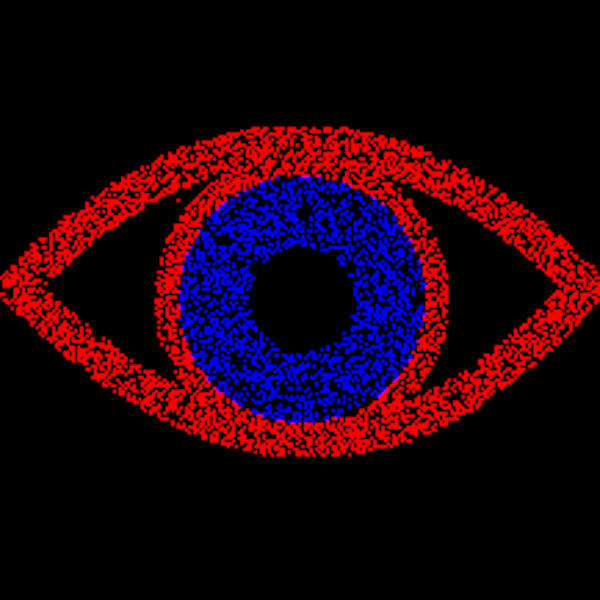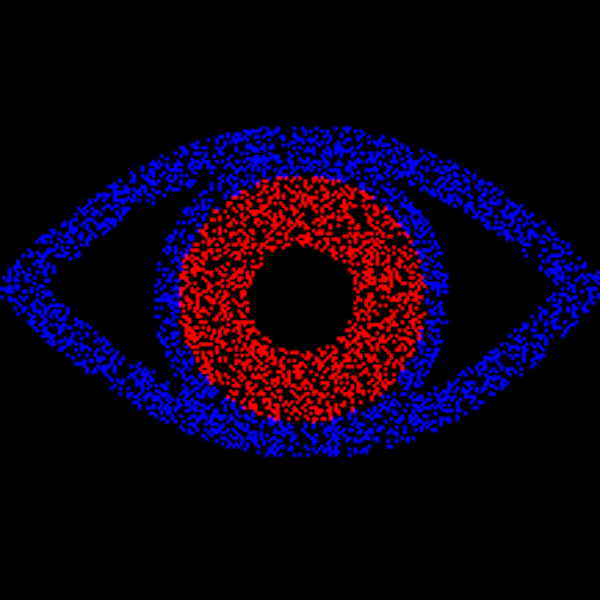The effect varies for different people. Take a moment and look at this. Some people don’t see anything special: just a blue iris in a red eye.

For me though, there is an incredibly strong depth illusion – the blue and the red appear as if they are at different distances.
I can enhance the effect by blinking rapidly, turning the brightness up on my screen and viewing in a dark room. Sometimes it disappears for a few seconds before snapping back in. Because the colours appear at different depths they even appear to glide separately when I move my head from side to side, something which is obviously impossible for a static image.
The effect is called chromostereopsis and it is weirding me out, for several reasons.
The first is that I’d thought I’d seen all the illusions, and this one is completely new to me. Like, guys, did you all know and weren’t telling?
The second is that there are big individual differences in perception of the effect. This isn’t just in terms of strength, although obviously I’m one of those it hits hard. People also differ in which colour looks closer. For most people it is red, with blue looking deeper or further away. I’m in the minority, so if you’re like me this reverse of the image above should look more natural: the iris set deeper than the surrounding eye.

The third reason this effect is weird to me is that stereo-depth illusions usually require two images, separately presented to each eye. This is how 3D cinema works – you wear red-green or polarising classes and the 3D parts of the film present two superimposed images, each image filtered out by only one lens, putting slightly different images in each eye. Your visual system combines the image and ‘discovers’ depth information, adding to the 3D perception of the objects shown. The superimposed images are why the film looks funny if you take the glasses off.

Chromostereopic illusions are true stereo illusions – they require the information to be combined across both eyes. There are many depth illusions which aren’t stereo illusions, but this isn’t one of them. You can prove this to yourself by making the effect disappear by closing one eye. The image stays the same, but it has to go in both eyes for the illusion of depth to occur. You can also try and find someone who is “stereoblind” and show them the illusion. A small percentage of the population don’t combine information across both eyes, and so only perceive depth via the other, monocular, cues. Our visual system is so adept at doing this that many people live their whole lives without realising they are stereoblind (although I suspect they tend not to go into professions which require exact depth perception, like juggling).
The way chromostereopsis works is not entirely understood. Even the great Michael Bach, who wrote for the Mind Hacks book, describes the explanation for the phenomenon as ‘multi-varied and intricate‘. That red and blue are at opposite ends of the light spectrum has something to do with it, and the consequent fact that different wavelengths of light will be focussed differently on the back of the eyes. This may also be why some people report that their glasses intensify the effect. The luminance of the image and the background also seems to be important.
The use of colour has a long history in art, from stained glass windows to video games, and probably many visual artists have discovered chromostereopsis by instinct. One of my favourite real-world uses is the set of the panel show Have I Got News For You:

For more on Depth Illusions, see the Mind Hacks book, chapters 20,22,24 and 31. For how I made the images, see the colophon on my personal blog.
More on the science: Kitaoka, A. (2016). Chromostereopsis. in Ming Ronnier Luo (Ed.), Encyclopedia of Color Science and Technology, Vol.1, New York; Springer (pp. 114-125).
Corrected 2022-05-18 The coloured part of the eye is the iris, not – as I originally wrote – the pupil (which is the black centre part)
“they even appear to glide separately when I move my head from side to side”
This part, for me, is easily explained as the result of chromatic aberration in the glasses I wear. If I take off my glasses (and bring my face close enough to the screen to see) that effect goes away. It’s most obvious in blue-purple lights in the real world, which will appear to separate into multiple lights and move differently as I move my head.
I am left-handed and saw the blue iris and black pupil lifted out of the image (but in the article I originally read, I had to first enlarge the image a bit).
I eat and write left-handed but everything else, right-handed.
I have a supposedly rare tumor on my brainstem that seems to have caused bouts of reverse-ism since I was very young. Also have mangled brain and neck arteries. Definitely all affects my cognitive functioning and causes blurred vision and optical illusion or interpretive differences, and there are probably so many people who don’t realize they have similar issues because unless you have great insurance or are paying cash, doctors/medical corporations won’t reveal the info or will deny needs treated. Mayo one if the worst. A big part of my job as an editor for many, many years was judging photos closely and looking over scatters of page spreads, where I would spy needed changes that others never did, tumor, headaches and all.
Thank you for the interesting graph.
(I also can’t ever remember iris from pupil. North, south, east, west is also tough if I’m supposed to quickly know a direction, like to turn west, or ‘open the north window’ in a room. Eek.
I came here to say what Nathan Williams did. With 1 cm thick CR39 lenses (Abbe number of 60, quite good actually) in my eye glasses red/blue on black always shift relative to each other as I move my head and that gives the feeling of depth. I guess I have cyborgchromostereopsis.